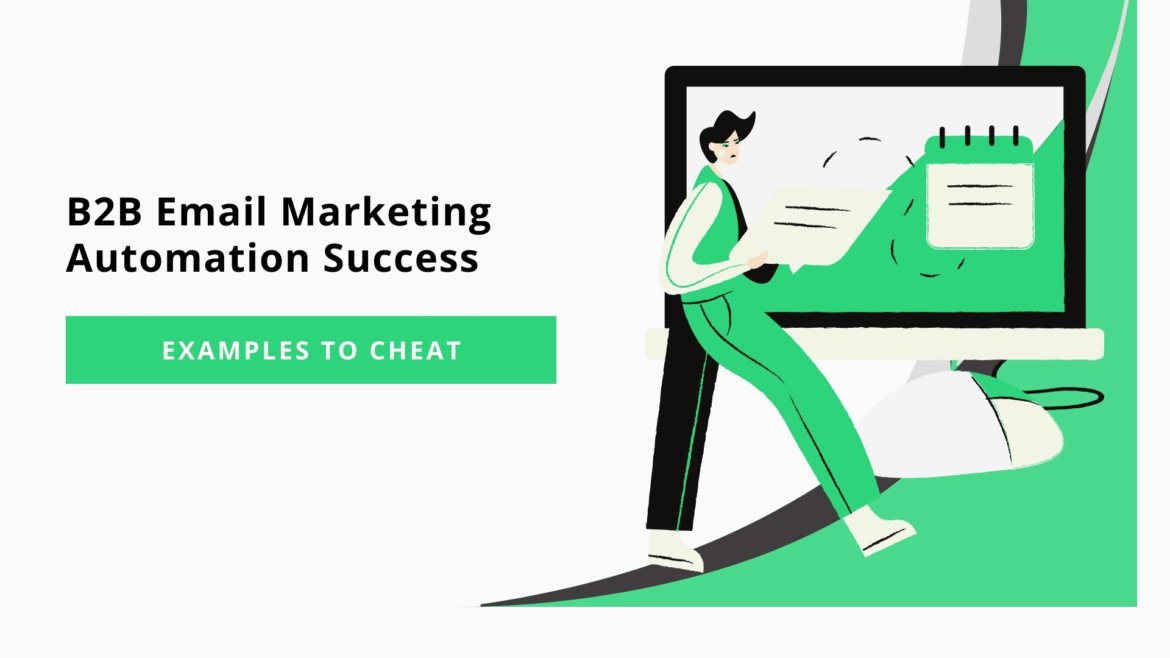In business-to-business (B2B) sales, a transaction occurs between two businesses. One provides the service, product, or information whereas the other purchases the service, product, or information. Because you are targeting businesses (and not individuals), your marketing should focus more on your customer’s needs from a logic standpoint. What are their needs that they have, and how can your offerings meet this need for them? It’s different from business-to-consumer marketing where, while the customers still have needs that need to be met, you may want to take more of an emotional approach at times. But when it comes to a business, key considerations when making a purchase include return on investment, total investment, time, and more. One of the ways you can reach potential new customers is through B2B email marketing.
Why B2B Email Marketing?
In B2B marketing, you can focus on channels like social media or your website, but email marketing is still tried and true. Email is the lifeline of all businesses and how most employees share information or communicate internally. But B2B email marketing has proven itself to be an important channel in a company’s overall B2B marketing.
One of the first reasons is that we need to look at businesses for what they are: People. Businesses are run by people and decisions that affect the business are made by people. So even though we are marketing to a business, we are really marketing to the decision-makers at that business. And when we look at it that way, it makes sense to use email. According to HubSpot:
Of millennials, 73% prefer to receive email communication from businesses
For purchasing decisions, 59% of people believe the marketing emails they receive influences them
To increase customer retention, 80% of business professionals believe email marketing helps

Email is the way to market but, like any marketing, requires a full team to do it and do it well. But to have an individual team member dedicated to identifying customers who haven’t opened your emails in a while and sending a re-engagement email or remembering to follow up with each new prospect is nearly impossible. That’s why automation is key in marketing but especially email marketing. And if you can automate something, you probably should.
Why Automate B2B Email Marketing?
Email marketing is effective, but it eats up a lot of resources (time and money) and requires quite a bit of creativity. To optimize your team’s time and efficiency, it is okay to “cheat” and automate where you can. It doesn’t make your email marketing efforts any less—but it can improve your results while making your life that much easier! There are several additional benefits of automating parts of your B2B email marketing besides saving time.
Cultivate Relationships
By automating your B2B email marketing, you can improve customer engagement and cultivate relationships with prospective customers. Automation can help make sure you are consistently (but not overwhelmingly) communicating with your customers, meaning you provide them more opportunities to interact and get to know you. Plus, this communication doesn’t have to be 9 to 5, Monday through Friday: with automation, you can send communication at any time of day, even on the weekends.
Market Smarter
You know the phrase, “Work smarter, not harder”? Successful marketing is working smarter. Not only are you optimizing your time and other resources, but you’re improving your marketing, too. An automation system can see how a contact interacted with your website and then send a follow up email relevant to their interaction. For example, if an individual had to provide an email to download a white paper you wrote on a main service offering of yours, you could have an email automatically sent to them that provides more information on that service offering.
Make It Personal
Automation software can help you more easily personalize the emails you are sending to your B2B marketing lists. You can base this personalization on actions taken, such as a “thank you” email for signing up for a newsletter, or based on user experience and interaction with the website, previous purchase history, or characteristics such as type of business and industry. Personalized emails are more likely to be opened, have better click-through rates, and overall generate a better response because they are more relevant to the recipient.
Automate Your B2B Email Marketing
Before you dive into all things automation, you need to create measurable goals. These are critical to testing your success: You need to know where you want to be, and you must establish a baseline (i.e., starting point) so you can accurately determine overall performance. What these goals are will look different at each business based on what you want to achieve. Sometimes a goal is as simple as growing a distribution list. You may be interested in getting more demo requests or paid subscribers. Whatever it is, you need to create a SMART goal for it.
SMART is an acronym for specific, measurable, attainable, relevant, and timely. These are key qualities in making a goal, because it provides details to what you’re trying to achieve. For example, setting a goal for “get more subscribers” is vague, doesn’t tell us how many is “more,” nor does it show the time in which we want to achieve it. But a SMART goal explicitly defines what we want to achieve, how we will measure that success, and how it helps our business goals. It also sets a timeline for meeting this goal, and it ensures that this goal is achievable based on certain criteria.
Automate Your Follow Up
Did you know that half of all sales only occur after the fifth contact with a customer? That’s quite a bit of follow up. If you don’t have the time to remember to keep following up, you can automate this process and have a strategic follow-up tool on your behalf. The benefit of this automation is that you can set the level of frequency with which you want to follow up. If you want to aggressively follow up, you can have a follow up email sent once or twice a day. If you want a more relaxed approach, you can follow up every three days. You can also customize this sequence based on your experiences in what works best. It is one less thing to remember, but it can help you close more sales.
Set Up Automatic Responses
Sometimes we’re worried that our email will get lost in the shuffle, so it’s mentally rewarding to receive an immediate response from the person we’re emailing. You see automatic responses a lot when you submit a ticket to a business’s customer service. An email is generated that tells the sender that you received the inquiry and that a team member should respond in the next 24 to 48 hours. You can do the same with your B2B email. Automate responses for actions that may not necessarily necessitate a response, such as confirming someone signing up for a subscription or sending a welcome email for creating a count. Even if someone on your team won’t actually respond (such as with a customer service inquiry), it is still important for your customer to receive some communication back from you.
Create a Sequential Email Campaign
A sequential email campaign, or a “drip” campaign, is exactly as it sounds: One email is sent, then a bit later, another, and then another, and then another. These B2B emails continue to flow until a desired result is met. Let’s say you are trying to get someone to sign up for a free trial. After an individual signs up to receive marketing communications from you, a sequential email campaign might look like the following:
- Welcome email 🡪 Sent immediately
- Email introducing product 🡪 Sent a day later
- Email providing more information about product 🡪 Sent two days later
- Email providing information about a free trial 🡪 Sent two days later
- Email reminder about a free trial 🡪 Sent three days later
Each email is on a schedule, but the first email will only send once the customer makes the initiating action. These emails are pre-written, but you can use personalization to make it more relevant to the recipient. Sequential email campaigns can be used to achieve various goals depending on how you incorporate it into your strategy.

Automatically Re-engage with Customers
There are many reasons why a customer will consistently not open their emails: They get too busy and forget to check, they don’t have time to check so they move it to the inbox, it is not relevant to them at that point, or they are no longer interested in the content but do not unsubscribe. To try to re-engage your customers, you can automate your efforts to re-engage them.
One way you can re-engage is by sending them the same email to customers who did not open it the first time. The difference is that, while the content is the same, the subject line is original. A different subject can be more intriguing, leading the customer to open it, whereas the other subject line disinterested them.
If a customer consistently does not open your email, you can opt to have them effectively re-subscribe. Send them a notice that you notice they have not opened the B2B emails you sent in a while, and would you like to still stay subscribed? While you may lose some subscribers, you won’t have lost the effort in trying to re-engage them thanks to automation.
Automate Customer On-Boarding
Whether a customer signs up for a trial or immediately signs up for your service, you’ll want to make sure they have all the information they need to get the most out of the service. That’s why automating customer on-boarding is key, because it starts the process immediately and doesn’t allow for time for them to get frustrated. You’ll want to set up a sequential B2B email marketing campaign for this as well.
Automating customer on-boarding is beneficial because you are assisting your customers and providing them with insight to get the most out of the service. At the same time, you are improving your team’s efficiency and saving resources because you need not have a dedicated team available to assist customers. While there will be some instances of specialized help, a strong automating on-boarding process will reduce the need for customer assistance.
Nurture Your Leads
When people sign up for your B2B email lists, they may not be at the stage where they are ready to make a purchase. But they are still a potential lead, and you want to make sure you nurture this lead since it could turn into a potential sale. By automating your B2B lead generation process, you can ensure that you are consistently communicating with them and opening them up more to the idea of making a purchase. After they have reached the stage where they feel informed and ready to decide, a salesperson can then take over.
Don’t Forget to Analyze
Automating your B2B email marketing efforts can give a great return on investment, but you’ll realize a better return if your strategy is where it needs to be. One significant part of any automation software is that it comes with built-in data collection, storing it neatly in one place for you to easily review. But you’re doing yourself a disservice if you only check it a handle of times or don’t analyze the data provided.
Automation can help to an extent, but it still comes down to creativity and knowing your audience for your email marketing to be successful. Remember those goals we set earlier? You’ll want to review them now after reviewing your data. Which goals did you meet, which did you exceed, and which missed the market? Your answers to these questions and more will help determine your next steps.
If you see that a particular area performed poorly, consider what changes you made, if any, and how that may have affected performance. Was the performance significantly worse this time than last quarter? If it was, then whatever change you made was probably not the right call. But if it was slightly better, you’ll want to wait until the next time you review to make the call on whether to cease those efforts. You need to give new tactics and strategies some time to work. If, in the next quarter, you don’t see a significant improvement, it would be time to re-evaluate and implement something new.


